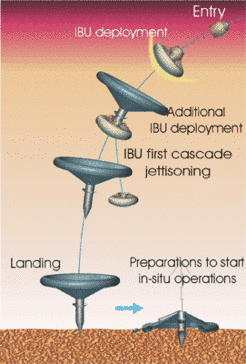
EDLS Concept
The main idea behind the MetNet Lander (MNL) vehicle is by using a state-of-the-art inflatable entry and descent systems instead of rigid heat shields and parachutes as earlier semi-hard landing devices have used. This way the ratio of the payload mass to the overall mass is optimized, and more mass and volume resources are spared for the science payload.
The MetNet Lander's atmospheric descent process can be partitioned into two phases:
- The primary aerodynamic or the Inflatable Braking Unit (IBU) deceleration phase
- The secondary aerodynamic or the Additional Inflatable Braking Unit (AIBU) deceleration phase.
During phase 1 the probe is decelerated by a torus-shaped IBU with external diameter of 1.0 m. During this phase the probe speed is reduced from hypersonic down to a speed suitable for deployment of the AIBU.
For the deceleration phase 2 an AIBU with an external diameter of 1.8m is used. When the AIBU is inflated (and hence taken into use) the IBU separates from the MetNet Lander due to a difference of ballistic an aerodynamic parameters between the IBU and the remaining MetNet Lander. During the deceleration phase 2 the probe speed is reduced to landing speed (44.6-57.6m/s).
Comparative reliability analysis between a parachute-based Entry, Descent and Landing System (EDLS) and other analogous approaches showed that the reliability of Entry, Descent and Landing (EDL) using the two cascaded IBUs is approximately 1.7 times higher than the one using a parachute system.
The scientific payload of the MetNet Mission encompasses separate instrument packages for the atmospheric surface operation phase. At the Martian surface the MNL will take panoramic pictures, and perform observations of pressure, temperature, humidity, wind direction and speed, as well as atmospheric optical depth.



